Optimizing Fleet Structure for Autonomous Electric Buses: A Route-Based Analysis in Aachen, Germany
Abstract
1. Introduction
1.1. Literature Review
1.2. Research Gap
- What vehicle capacities are economically attractive for operating a route with autonomous electric buses?
- Which electric bus concepts are economically attractive for operation with autonomous vehicles of different passenger capacities?
- How do the energy constraints of battery buses affect network adaptations for autonomous buses?
2. Case Study
2.1. Bus Route 7 in Aachen, Germany
2.2. Bus Types
2.3. Cost Assumptions
3. Methods
3.1. Timetabling
3.2. Vehicle Scheduling
| Algorithm 1: ALNS heuristic for E-VSP | |
| 1: | ; |
| 2: | ; |
| 3: | while stop criteria are not met do |
| 4: | Select destroy and repair method based on |
| 5: | |
| 6: | ; |
| 7: | if then |
| 8: | ; |
| 9: | if then |
| 10: | ; |
| 11: | ; |
| 12: | end |
| 13: | return |
3.3. Calculation of TCO
4. Results
- Base vehicle: investment costs for the base vehicle—without batteries.
- Vehicle maintenance: maintenance costs for the base vehicle.
- Battery: investment costs for the battery as well as for the replacement of the battery at the end of its service life.
- Charging infrastructure: investment costs for the battery as well as for the replacement of the battery at the end of its service life.
- Energy: operative costs for electricity and diesel respectively.
- Vehicle monitoring: operative costs for monitoring the vehicles.
- Driver: operative costs for the driving personnel.
4.1. Solo Buses
4.2. Midi Buses
4.3. Mini Buses
4.4. Micro Buses
5. Discussion
- What vehicle capacities are economically attractive for operating a route with autonomous electric buses?
- 2.
- Which electric bus concepts are economically attractive for operation with autonomous vehicles of different passenger capacities?
- 3.
- How do the energy constraints of battery buses affect network adaptations for autonomous buses?
Outlook and Challenges
6. Conclusions
- The elimination of driver costs renders the use of autonomous electric buses economically attractive. For instance, the total cost of ownership for solo buses is reduced from EUR 10.9 million to EUR 5.2 million for a timetable with constant service frequency. Furthermore, smaller vehicle types benefit even more from the elimination of driver costs, rendering them economically feasible.
- Even when this effect is taken into account, the economic competitiveness of smaller vehicle capacities can only be achieved when the timetable is synchronized with typical ridership. For example, the total cost of ownership for autonomous electric micro buses is EUR 9.0 million for a constant frequency schedule, while it is only EUR 5.9 million for a timetable that is predominantly based on typical ridership.
- The additional costs associated with bus electrification can be effectively managed by selecting a coherent concept. In particular, the variation in the most economically viable electric bus concept can range from cost equivalence to an additional cost of up to EUR 0.8 million, depending on the vehicle capacity and timetable scenario chosen.
- The choice of timetable scenario played a critical role in determining the success of different electric bus concepts. A focus on actual ridership patterns provides opportunities for service breaks, especially for smaller vehicles, which makes it easier to charge electric vehicles. In such scenarios, designs with fewer charging stations and lower charging power become much more attractive.
- Smaller vehicles have higher energy consumption per passenger, which contributes significantly to operating costs and requires an expanded battery and charging infrastructure. Reducing energy consumption in autonomous electric vehicles is therefore highly beneficial.
- In contrast to previous findings regarding autonomous diesel buses, aligning off-peak and peak frequencies is less advantageous for electric buses due to their energy limitations. When integrating autonomous buses, it is of paramount importance to consider the distinctive requirements of electric buses in network design modifications.
Author Contributions
Funding
Institutional Review Board Statement
Informed Consent Statement
Data Availability Statement
Conflicts of Interest
References
- Heikoop, D.D.; Nuñez Velasco, J.P.; Boersma, R.; Bjørnskau, T.; Hagenzieker, M.P. Chapter Two—Automated bus systems in Europe: A systematic review of passenger experience and road user interaction. Adv. Transp. Policy Plan. 2020, 5, 51–71. [Google Scholar] [CrossRef]
- Anund, A.; Ludovic, R.; Caroleo, B.; Hardestam, H.; Dahlman, A.; Skogsmo, I.; Nicaise, M.; Arnone, M. Lessons learned from setting up a demonstration site with autonomous shuttle operation—Based on experience from three cities in Europe. J. Urban Mobil. 2022, 2, 100021. [Google Scholar] [CrossRef]
- Gertz, C.; Kreutzfeldt, J.; Flämig, H.; Hinckeldeyn, J.; Maaß, J.B.; Grote, M.; Tjaden, S.; Thiel, M.; Schrick, M.; Stargardt, J.; et al. Endbericht des Projektes TaBuLa-LOG. Available online: http://hdl.handle.net/11420/13428 (accessed on 2 April 2024).
- Masood, K.; Zoppi, M.; Fremont, V.; Molfino, R.M. From Drive-By-Wire to Autonomous Vehicle: Urban Freight Vehicle Perspectives. Sustainability 2021, 13, 1169. [Google Scholar] [CrossRef]
- Richter, T.; Brenck, A.; Böckler, L.; Egoldt, A. Autonomer öffentlicher Nahverkehr im ländlichen Raum (Landkreis Ostprignitz-Ruppin), Wirkungsforschung zu neuen Formen innovativer öffentlicher Mobilität und Nutzerakzeptanz anhand eines Probebetriebs in der Modellregion Ostprignitz-Ruppin: Endbericht. Available online: https://www.tib.eu/de/suchen/id/TIBKAT%3A1795015837 (accessed on 2 April 2024).
- Ainsalu, J.; Arffman, V.; Bellone, M.; Ellner, M.; Haapamäki, T.; Haavisto, N.; Josefson, E.; Ismailogullari, A.; Lee, B.; Madland, O.; et al. State of the Art of Automated Buses. Sustainability 2018, 10, 3118. [Google Scholar] [CrossRef]
- Miskolczi, M.; Földes, D.; Munkácsy, A.; Jászberényi, M. Urban mobility scenarios until the 2030s. Sustain. Cities Soc. 2021, 72, 103029. [Google Scholar] [CrossRef]
- ZeEUS Project. ZeEUS eBus Report #2: An Updated Overview of Electric Buses in Europe. Available online: https://zeeus.eu/uploads/publications/documents/zeeus-report2017-2018-final.pdf (accessed on 2 April 2024).
- Office Publications. Directive (EU) 2019/ 1161 of the European Parliament and of the Council—of 20 June 2019—Amending Directive 2009/33/EC on the Promotion of Clean and Energy-Efficient Road Transport Vehicles. Available online: https://eur-lex.europa.eu/legal-content/EN/ALL/?uri=CELEX%3A32019L1161 (accessed on 3 April 2024).
- Sheng, Y.; Lin, Y.; Zeng, H.; Yu, Y.; Guo, Q.; Xie, S. Emission-concerned coordinated dispatching of electrified autonomous mobility-on-demand system and power system incorporating heterogeneous spatiotemporal scales. Sustain. Cities Soc. 2023, 98, 104755. [Google Scholar] [CrossRef]
- Rahman, M.M.; Thill, J.-C. Impacts of connected and autonomous vehicles on urban transportation and environment: A comprehensive review. Sustain. Cities Soc. 2023, 96, 104649. [Google Scholar] [CrossRef]
- Othman, K. Exploring the implications of autonomous vehicles: A comprehensive review. Innov. Infrastruct. Solut. 2022, 7, 165. [Google Scholar] [CrossRef]
- Hatzenbühler, J.; Cats, O.; Jenelius, E. Transitioning towards the deployment of line-based autonomous buses: Consequences for service frequency and vehicle capacity. Transp. Res. Part A Policy Pract. 2020, 138, 491–507. [Google Scholar] [CrossRef]
- Fielbaum, A. Strategic Public Transport Design Using Autonomous Vehicles and Other New Technologies. Int. J. ITS Res. 2020, 18, 183–191. [Google Scholar] [CrossRef]
- Nagy, V.; Horváth, B. The effects of autonomous buses to vehicle scheduling system. Procedia Comput. Sci. 2020, 170, 235–240. [Google Scholar] [CrossRef]
- Gkiotsalitis, K.; Schmidt, M.; van der Hurk, E. Subline frequency setting for autonomous minibusses under demand uncertainty. Transp. Res. Part C Emerg. Technol. 2022, 135, 103492. [Google Scholar] [CrossRef]
- Bösch, P.M.; Becker, F.; Becker, H.; Axhausen, K.W. Cost-based analysis of autonomous mobility services. Transp. Policy 2018, 64, 76–91. [Google Scholar] [CrossRef]
- Poinsignon, F.; Chen, L.; Jiang, S.; Gao, K.; Badia, H.; Jenelius, E. Autonomous Vehicle Fleets for Public Transport: Scenarios and Comparisons. Green Energy Intell. Transp. 2022, 1, 100019. [Google Scholar] [CrossRef]
- Hatzenbühler, J.; Cats, O.; Jenelius, E. Network design for line-based autonomous bus services. Transportation 2022, 49, 467–502. [Google Scholar] [CrossRef]
- Sadrani, M.; Tirachini, A.; Antoniou, C. Optimization of service frequency and vehicle size for automated bus systems with crowding externalities and travel time stochasticity. Transp. Res. Part C Emerg. Technol. 2022, 143, 103793. [Google Scholar] [CrossRef]
- Harris, A.; Soban, D.; Smyth, B.M.; Best, R. A probabilistic fleet analysis for energy consumption, life cycle cost and greenhouse gas emissions modelling of bus technologies. Appl. Energy 2020, 261, 114422. [Google Scholar] [CrossRef]
- Rogge, M.; Wollny, S.; Sauer, D.U. Fast Charging Battery Buses for the Electrification of Urban Public Transport—A Feasibility Study Focusing on Charging Infrastructure and Energy Storage Requirements. Energies 2015, 8, 4587–4606. [Google Scholar] [CrossRef]
- Jefferies, D.; Göhlich, D. A Comprehensive TCO Evaluation Method for Electric Bus Systems Based on Discrete-Event Simulation Including Bus Scheduling and Charging Infrastructure Optimisation. World Electr. Veh. J. 2020, 11, 56. [Google Scholar] [CrossRef]
- Rogge, M.; van der Hurk, E.; Larsen, A.; Sauer, D.U. Electric bus fleet size and mix problem with optimization of charging infrastructure. Appl. Energy 2018, 211, 282–295. [Google Scholar] [CrossRef]
- Göhlich, D.; Syré, A.; van der Schoor, M.; Jefferies, D.; Grahle, A.; Heide, L. Design Methodologies for Sustainable Mobility Systems; Springer: Cham, Switzerland, 2021; pp. 123–144. [Google Scholar] [CrossRef]
- Sistig, H.M.; Sauer, D.U. Metaheuristic for the integrated electric vehicle and crew scheduling problem. Appl. Energy 2023, 339, 120915. [Google Scholar] [CrossRef]
- Lajunen, A. Lifecycle costs and charging requirements of electric buses with different charging methods. J. Clean. Prod. 2018, 172, 56–67. [Google Scholar] [CrossRef]
- Lajunen, A. Energy consumption and cost-benefit analysis of hybrid and electric city buses. Transp. Res. Part C Emerg. Technol. 2014, 38, 1–15. [Google Scholar] [CrossRef]
- Perumal, S.S.; Lusby, R.M.; Larsen, J. Electric bus planning & scheduling: A review of related problems and methodologies. Eur. J. Oper. Res. 2022, 301, 395–413. [Google Scholar] [CrossRef]
- Meinrenken, C.J.; Lackner, K.S. Fleet view of electrified transportation reveals smaller potential to reduce GHG emissions. Appl. Energy 2015, 138, 393–403. [Google Scholar] [CrossRef]
- Jara-Díaz, S.; Fielbaum, A.; Gschwender, A. Optimal fleet size, frequencies and vehicle capacities considering peak and off-peak periods in public transport. Transp. Res. Part A Policy Pract. 2017, 106, 65–74. [Google Scholar] [CrossRef]
- Jansson, J.O. A Simple Bus Line Model for Optimisation of Service Frequency and Bus Size. Available online: https://jtep.org/journal/a-simple-bus-line-model-for-optimisation-of-service-frequency-and-bus-size-3/ (accessed on 2 April 2024).
- Cats, O.; Glück, S. Frequency and Vehicle Capacity Determination using a Dynamic Transit Assignment Model. Transp. Res. Rec. 2019, 2673, 574–585. [Google Scholar] [CrossRef]
- Oldfield, R.H.; Bly, P.H. An analytic investigation of optimal bus size. Transp. Res. Part B Methodol. 1988, 22, 319–337. [Google Scholar] [CrossRef]
- Buba, A.T.; Lee, L.S. A differential evolution for simultaneous transit network design and frequency setting problem. Expert Syst. Appl. 2018, 106, 277–289. [Google Scholar] [CrossRef]
- Badia, H.; Jenelius, E. Design and operation of feeder systems in the era of automated and electric buses. Transp. Res. Part A Policy Pract. 2021, 152, 146–172. [Google Scholar] [CrossRef]
- Xu, X.; Yu, Y.; Long, J. Integrated electric bus timetabling and scheduling problem. Transp. Res. Part C Emerg. Technol. 2023, 149, 104057. [Google Scholar] [CrossRef]
- Manzolli, J.A.; Trovão, J.P.; Antunes, C.H. A review of electric bus vehicles research topics—Methods and trends. Renew. Sustain. Energy Rev. 2022, 159, 112211. [Google Scholar] [CrossRef]
- Azad, M.; Hoseinzadeh, N.; Brakewood, C.; Cherry, C.R.; Han, L.D. Fully Autonomous Buses: A Literature Review and Future Research Directions. J. Adv. Transp. 2019, 2019, 1–16. [Google Scholar] [CrossRef]
- Esri. “Streets” [basemap]. Scale Not Given. “World Street Map”. Available online: https://www.arcgis.com/home/item.html?id=de26a3cf4cc9451298ea173c4b324736 (accessed on 2 April 2024).
- Szilassy, P.Á.; Földes, D. Consumption estimation method for battery-electric buses using general line characteristics and temperature. Energy 2022, 261, 125080. [Google Scholar] [CrossRef]
- Vepsäläinen, J.; Otto, K.; Lajunen, A.; Tammi, K. Computationally efficient model for energy demand prediction of electric city bus in varying operating conditions. Energy 2019, 169, 433–443. [Google Scholar] [CrossRef]
- Göhlich, D.; Ly, T.-A.; Kunith, A.; Jefferies, D. Economic Assessment of Different Air-conditioning and Heating Systems for Electric City Buses Based on Comprehensive Energetic Simulations. WEVJ 2015, 7, 398–406. [Google Scholar] [CrossRef]
- Cigarini, F.; Fay, T.-A.; Artemenko, N.; Göhlich, D. Modeling and Experimental Investigation of Thermal Comfort and Energy Consumption in a Battery Electric Bus. World Electr. Veh. J. 2021, 12, 7. [Google Scholar] [CrossRef]
- Cigarini, F.; Schminkel, P.; Sonnekalb, M.; Best, P.; Göhlich, D. Determination of improved climatic conditions for thermal comfort and energy efficiency in electric buses. Appl. Ergon. 2022, 105, 103856. [Google Scholar] [CrossRef] [PubMed]
- Figgener, J.; Tepe, B.; Rücker, F.; Schoeneberger, I.; Hecht, C.; Jossen, A.; Sauer, D.U. The influence of frequency containment reserve flexibilization on the economics of electric vehicle fleet operation. J. Energy Storage 2022, 53, 105138. [Google Scholar] [CrossRef]
- Yuan, X.; Zhang, C.; Hong, G.; Huang, X.; Li, L. Method for evaluating the real-world driving energy consumptions of electric vehicles. Energy 2017, 141, 1955–1968. [Google Scholar] [CrossRef]
- NOW GmbH. Programmbegleitforschung Innovative Antriebe und Fahrzeuge. Available online: https://www.now-gmbh.de/wp-content/uploads/2022/04/NOW_Abschlussbericht_Begleitforschung-Bus.pdf (accessed on 2 April 2024).
- Estrada, M.; Mensión, J.; Salicrú, M.; Badia, H. Charging operations in battery electric bus systems considering fleet size variability along the service. Transp. Res. Part C Emerg. Technol. 2022, 138, 103609. [Google Scholar] [CrossRef]
- Nykvist, B.; Nilsson, M. Rapidly falling costs of battery packs for electric vehicles. Nat. Clim. Chang. 2015, 5, 329–332. [Google Scholar] [CrossRef]
- Nykvist, B.; Sprei, F.; Nilsson, M. Assessing the progress toward lower priced long range battery electric vehicles. Energy Policy 2019, 124, 144–155. [Google Scholar] [CrossRef]
- klimaaktiv mobil. Marktübersicht Elektro- und Wasserstoffbusse. Available online: https://www.klimaaktiv.at/dam/jcr:d2a6e621-2e54-459b-be69-6b264f05ba24/KAM_2021_Marktuebersicht_Elektrobusse.pdf (accessed on 2 April 2024).
- Duffner, F.; Mauler, L.; Wentker, M.; Leker, J.; Winter, M. Large-scale automotive battery cell manufacturing: Analyzing strategic and operational effects on manufacturing costs. Int. J. Prod. Econ. 2021, 232, 107982. [Google Scholar] [CrossRef]
- Hecht, C.; Figgener, J.; Sauer, D.U. Analysis of electric vehicle charging station usage and profitability in Germany based on empirical data. iScience 2022, 25, 105634. [Google Scholar] [CrossRef]
- Wen, M.; Linde, E.; Ropke, S.; Mirchandani, P.; Larsen, A. An adaptive large neighborhood search heuristic for the Electric Vehicle Scheduling Problem. Comput. Oper. Res. 2016, 76, 73–83. [Google Scholar] [CrossRef]
- van Kooten Niekerk, M.E.; van den Akker, J.M.; Hoogeveen, J.A. Scheduling electric vehicles. Public Transp. 2017, 9, 155–176. [Google Scholar] [CrossRef]
- Perumal, S.S.; Dollevoet, T.; Huisman, D.; Lusby, R.M.; Larsen, J.; Riis, M. Solution approaches for integrated vehicle and crew scheduling with electric buses. Comput. Oper. Res. 2021, 132, 105268. [Google Scholar] [CrossRef]
- Perumal, S.S.; Lusby, R.M.; Larsen, J. A Review of Integrated Approaches for Optimizing Electric Vehicle and Crew Schedules. Available online: https://orbit.dtu.dk/en/publications/a-review-of-integrated-approaches-for-optimizing-electric-vehicle (accessed on 2 April 2024).
- Erdelić, T.; Carić, T. A Survey on the Electric Vehicle Routing Problem: Variants and Solution Approaches. J. Adv. Transp. 2019, 2019, 5075671. [Google Scholar] [CrossRef]
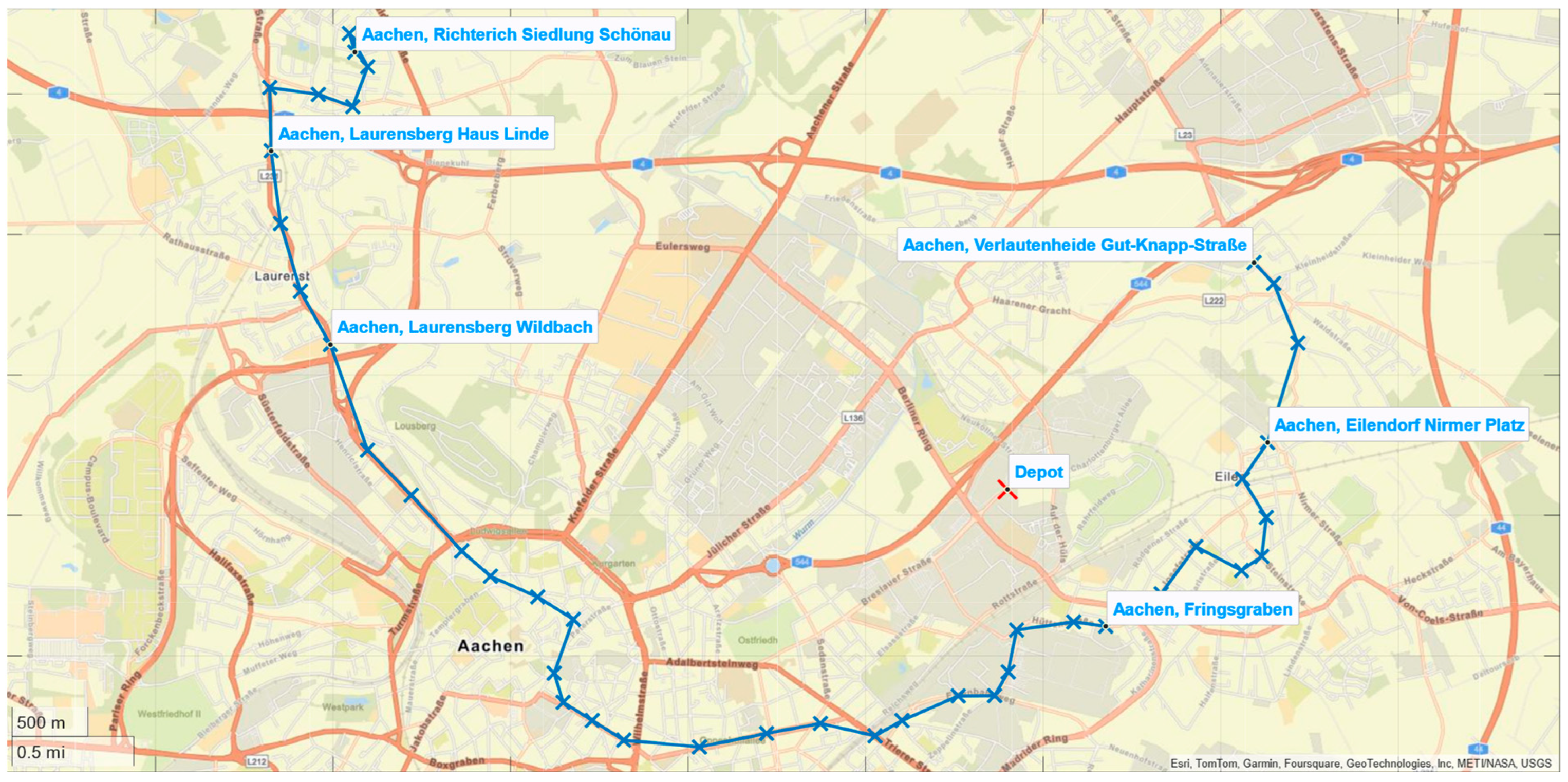
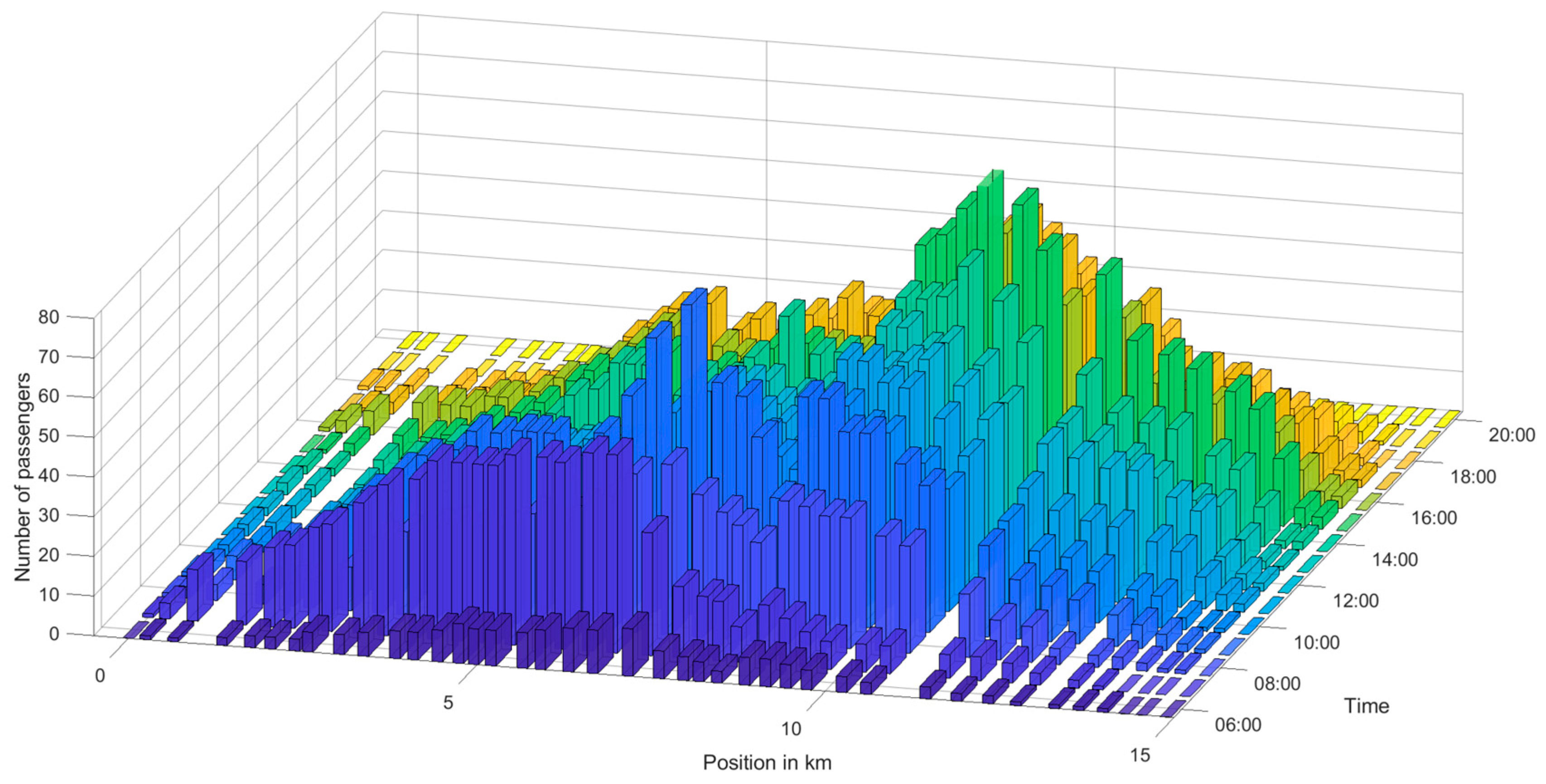



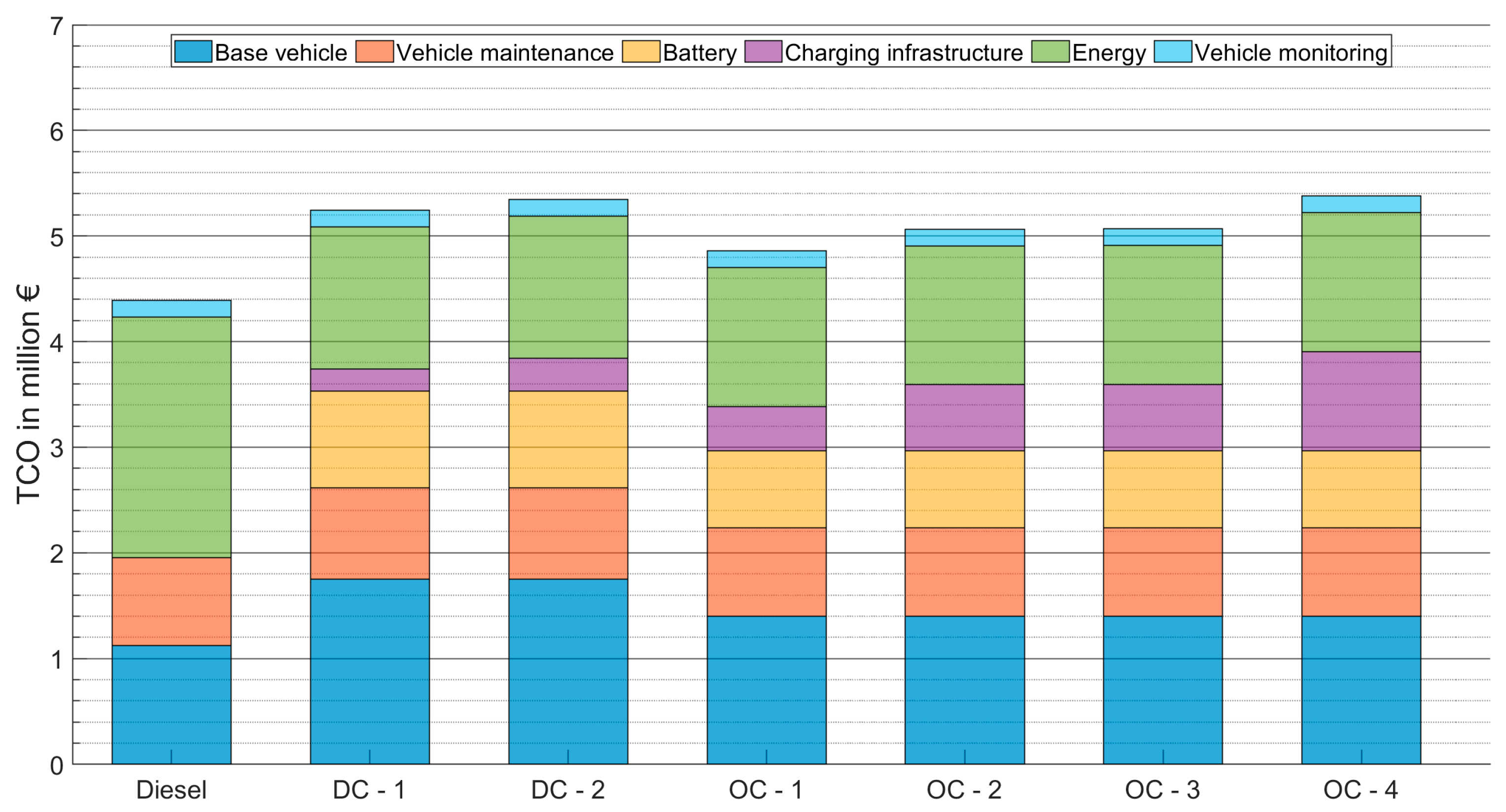
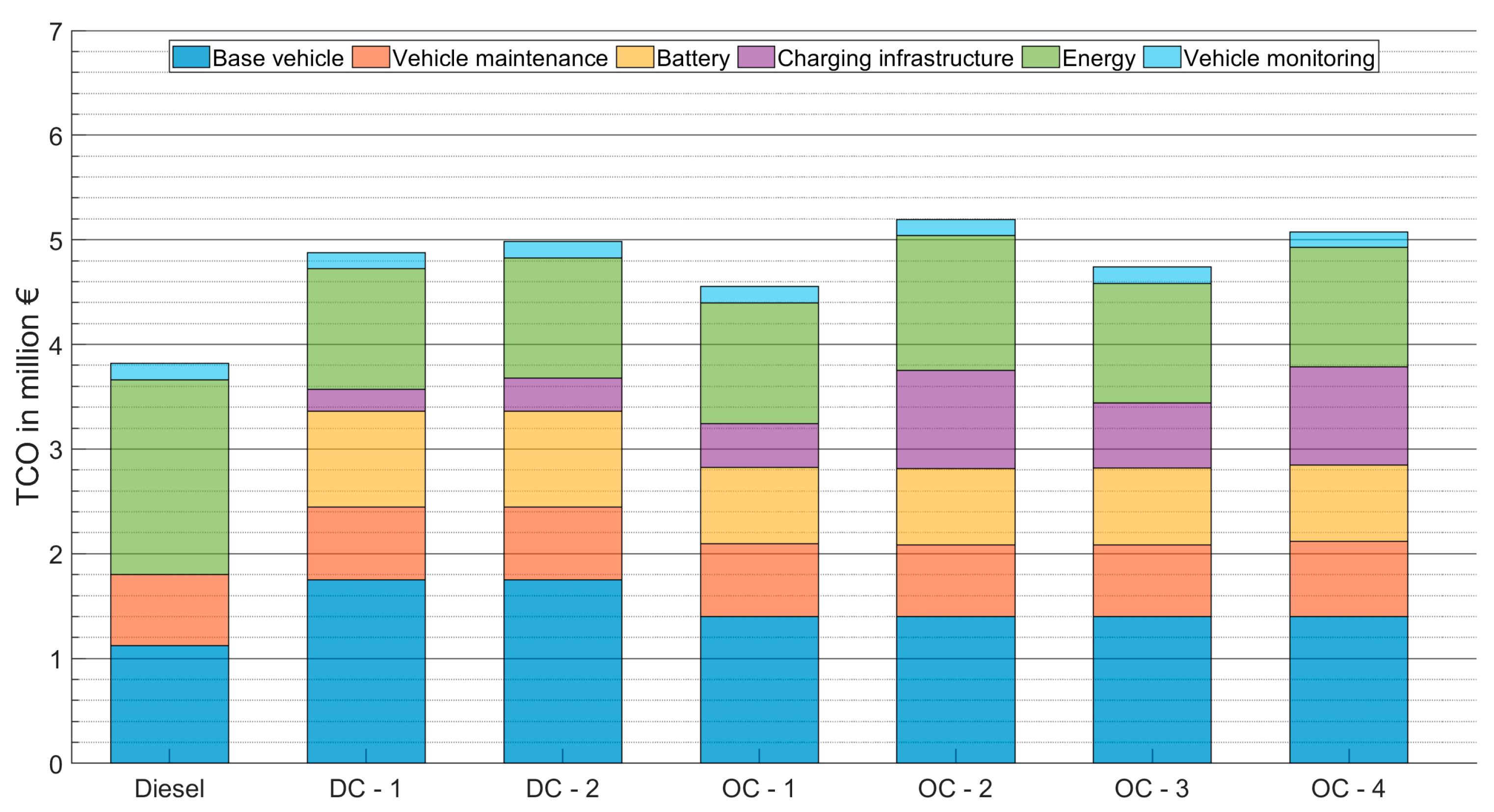
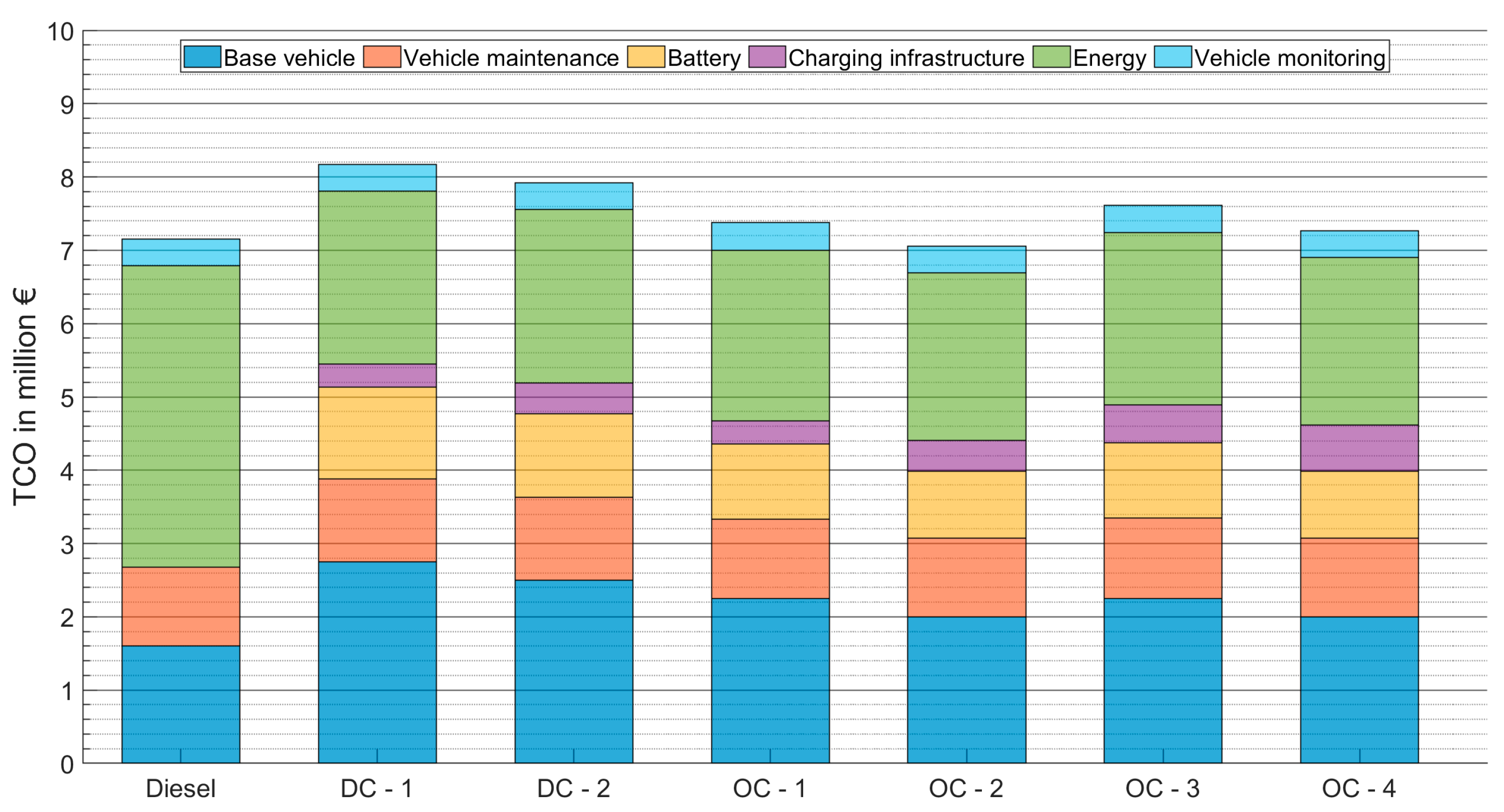

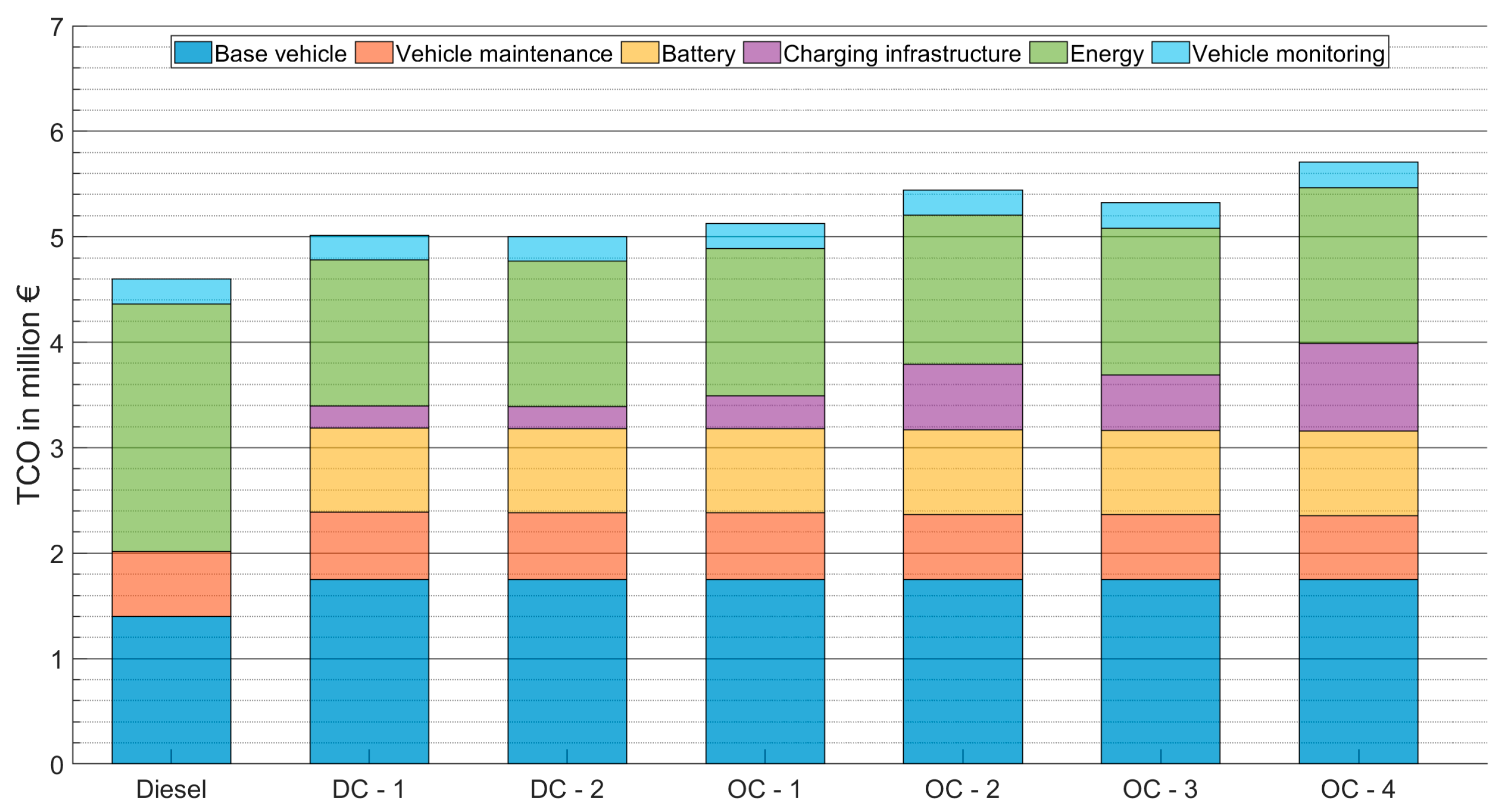
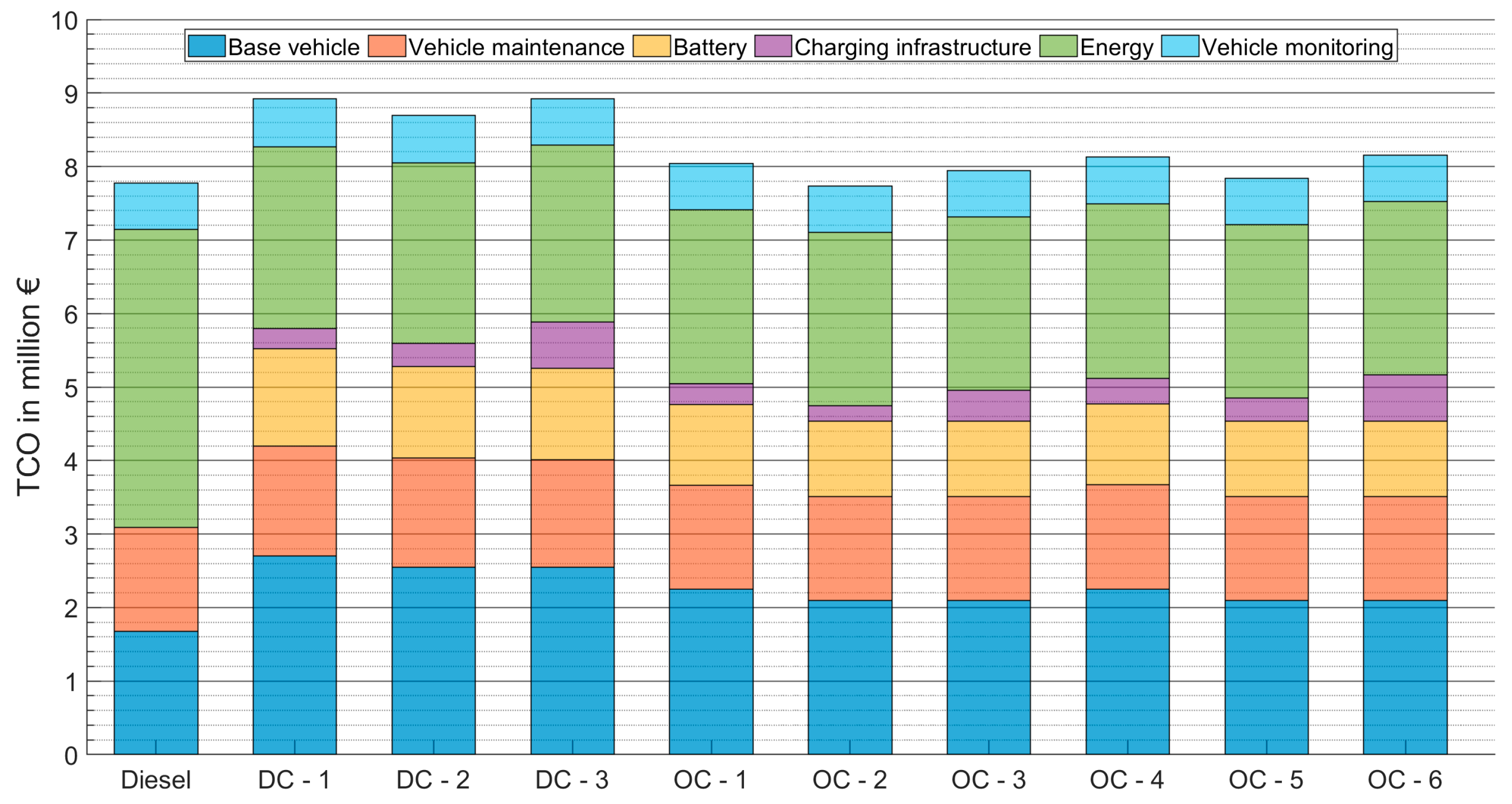

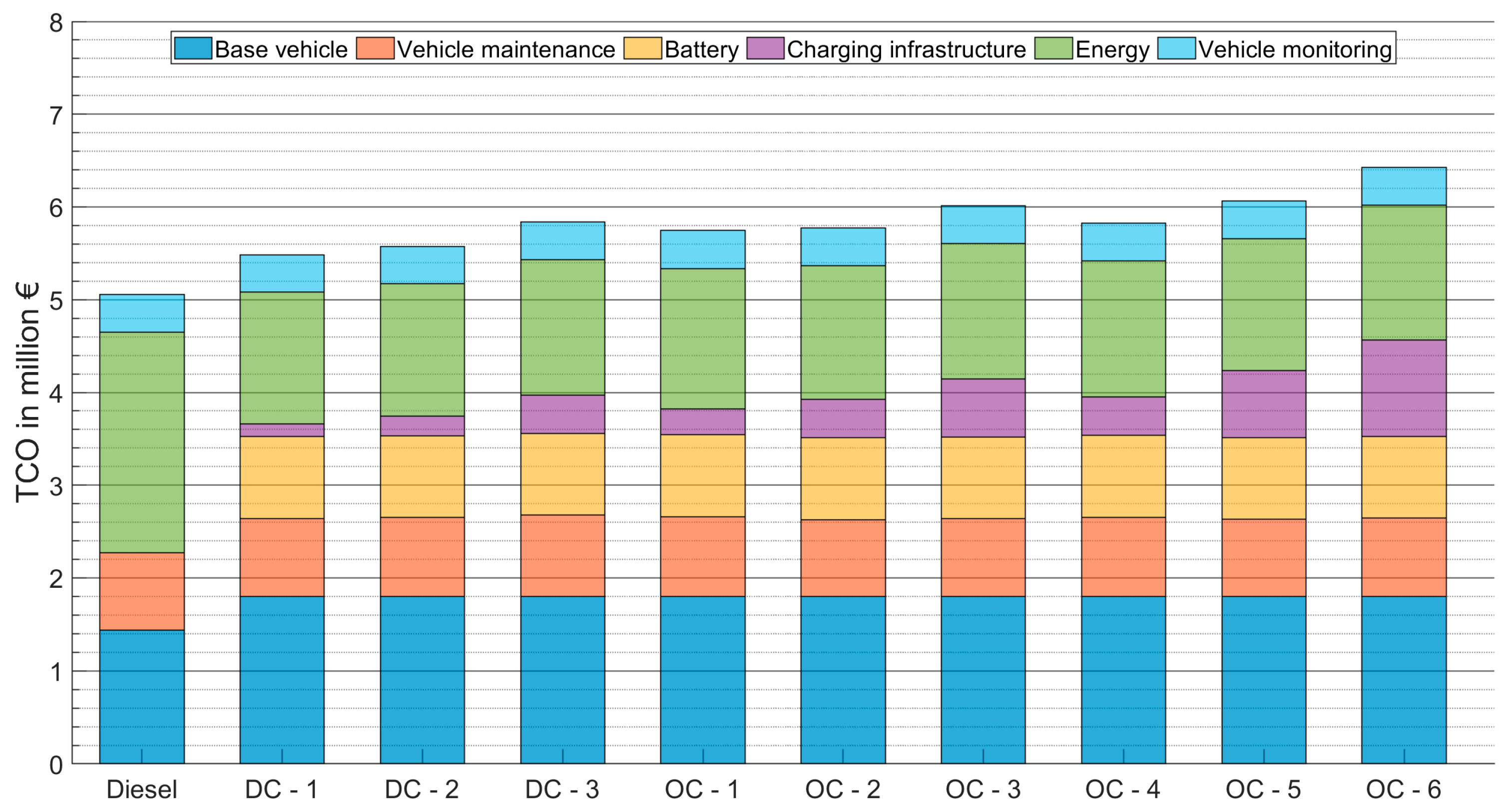
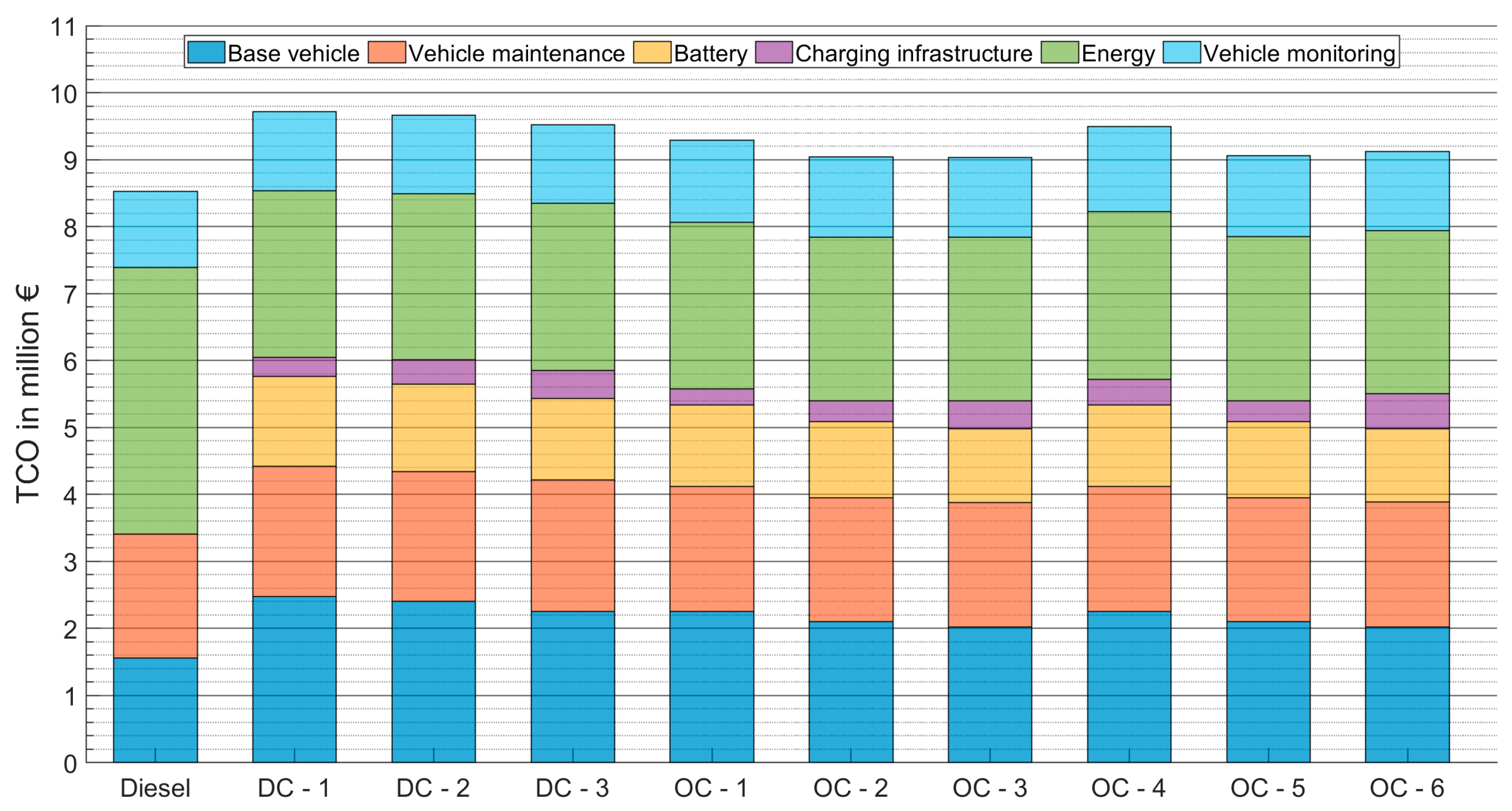


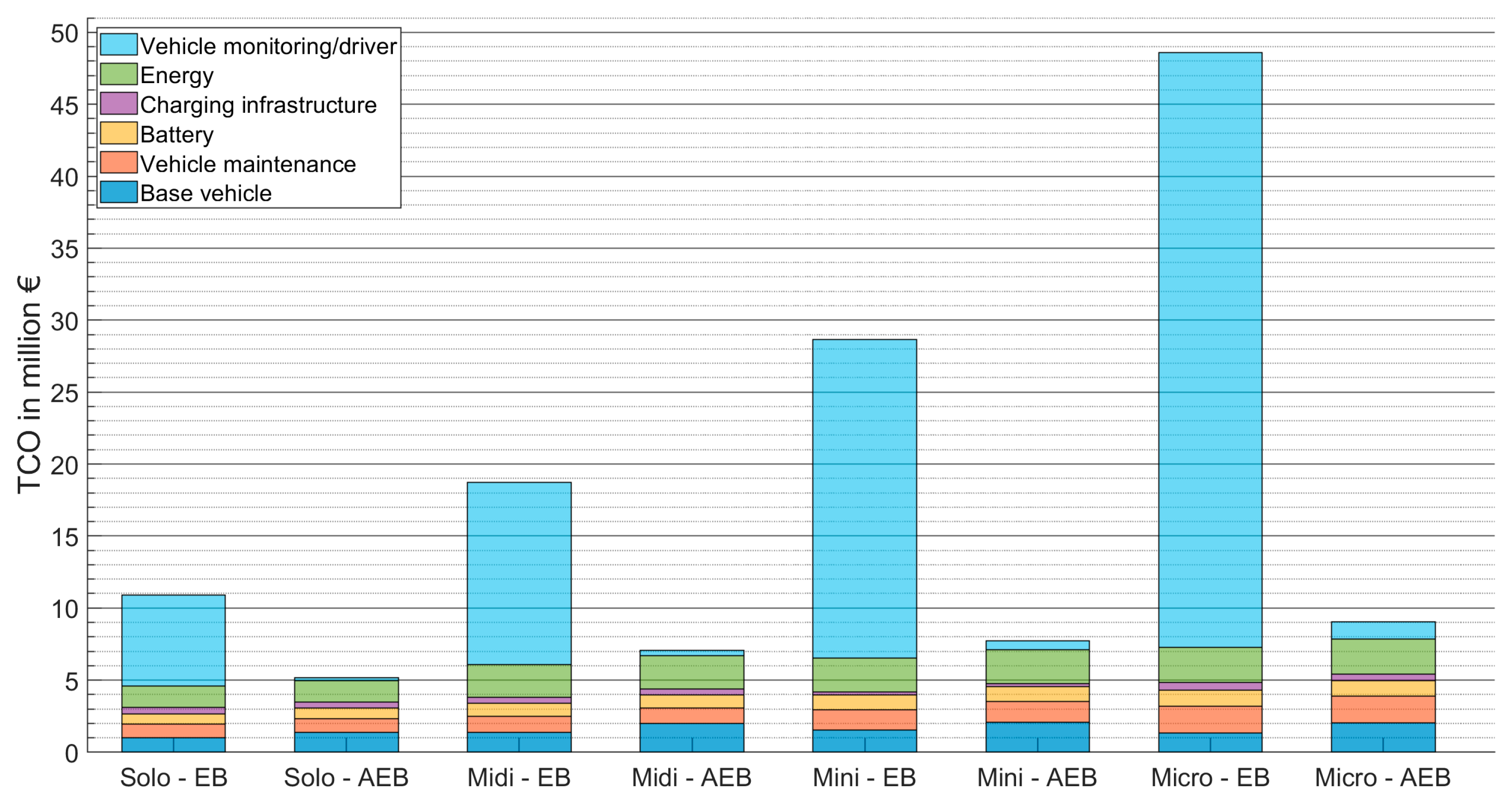
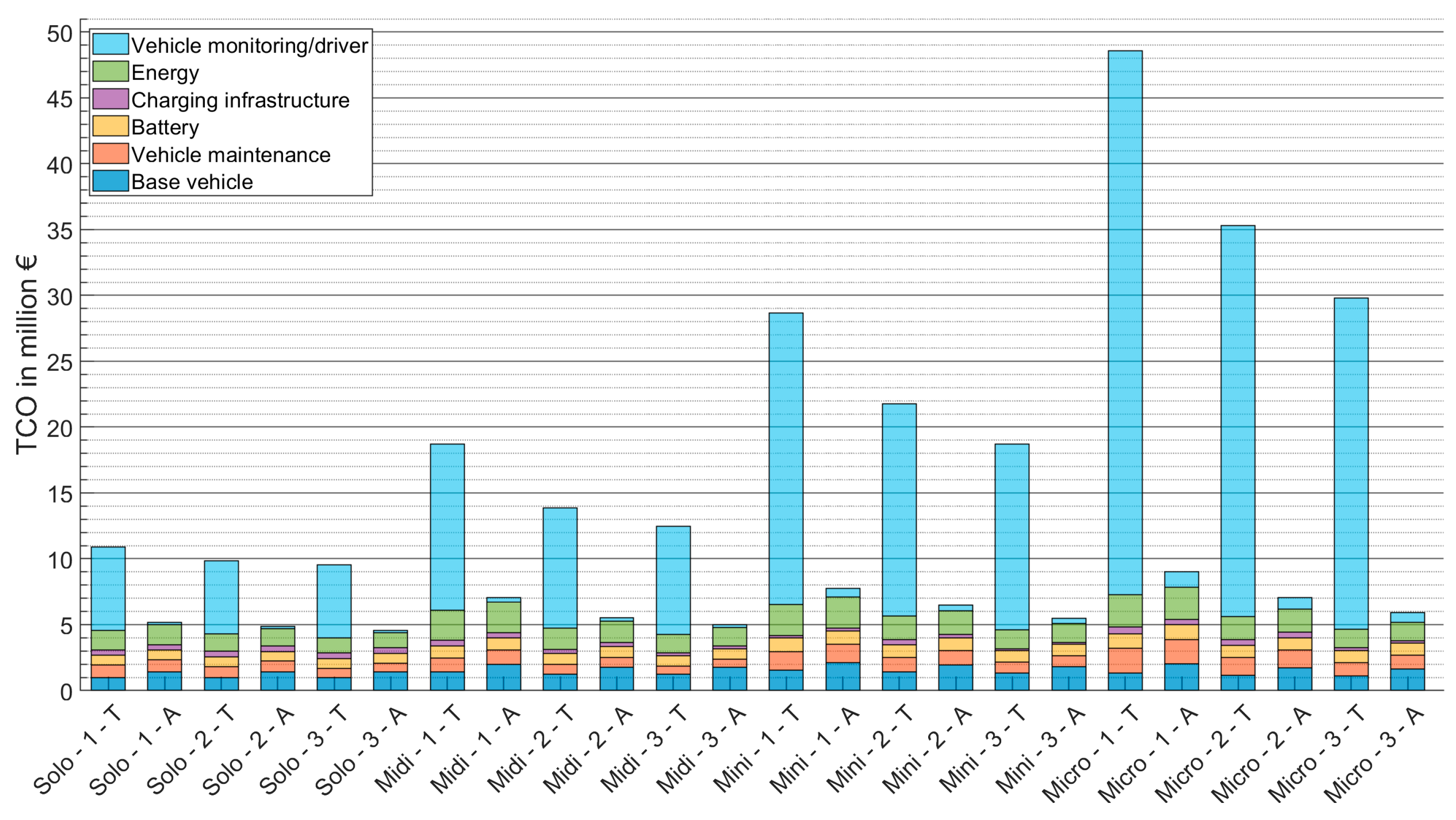
| Name | Battery Capacity (Usable/Installed) kWh | Charging Locations | Charging Power (Usable/Installed) kW |
|---|---|---|---|
| Micro bus—diesel | - | - | - |
| Micro bus—DC-1 | 72/100 | D | 40/50 |
| Micro bus—DC-2 | 72/100 | D | 60/75 |
| Micro bus—DC-3 | 72/100 | D | 120/150 |
| Micro bus—OC-1 | 72/100 | D, GKS | 40/50 |
| Micro bus—OC-2 | 72/100 | D, GKS | 60/75 |
| Micro bus—OC-3 | 72/100 | D, GKS | 120/150 |
| Micro bus—OC-4 | 72/100 | D, GKS, SS | 40/50 |
| Micro bus—OC-5 | 72/100 | D, GKS, SS | 60/75 |
| Micro bus—OC-6 | 72/100 | D, GKS, SS | 120/150 |
| Mini bus—diesel | - | - | - |
| Mini bus—DC-1 | 130/180 | D | 80/100 |
| Mini bus—DC-2 | 130/180 | D | 120/150 |
| Mini bus—DC-3 | 130/180 | D | 240/300 |
| Mini bus—OC-1 | 130/180 | D, GKS | 80/100 |
| Mini bus—OC-2 | 130/180 | D, GKS | 120/150 |
| Mini bus—OC-3 | 130/180 | D, GKS | 240/300 |
| Mini bus—OC-4 | 130/180 | D, GKS, SS | 80/100 |
| Mini bus—OC-5 | 130/180 | D, GKS, SS | 120/150 |
| Mini bus—OC-6 | 130/180 | D, GKS, SS | 240/300 |
| Midi bus—diesel | - | - | - |
| Midi bus—DC-1 | 202/280 | D | 120/150 |
| Midi bus—DC-2 | 202/280 | D | 240/300 |
| Midi bus—OC-1 | 202/280 | D, GKS | 120/150 |
| Midi bus—OC-2 | 202/280 | D, GKS | 240/300 |
| Midi bus—OC-3 | 202/280 | D, GKS, SS | 120/150 |
| Midi bus—OC-4 | 202/280 | D, GKS, SS | 240/300 |
| Solo bus—diesel | - | - | - |
| Solo bus—DC-1 | 324/450 | D | 240/300 |
| Solo bus—DC-2 | 324/450 | D | 360/450 |
| Solo bus—OC-1 | 324/450 | D, GKS | 240/300 |
| Solo bus—OC-2 | 324/450 | D, GKS | 360/450 |
| Solo bus—OC-3 | 324/450 | D, GKS, SS | 240/300 |
| Solo bus—OC-4 | 324/450 | D, GKS, SS | 360/450 |
| Traction (Deadhead/Service) kWh/km | Auxiliary Consumers (Average/Worst-Case) kW | Diesel Bus L/km | |
|---|---|---|---|
| Micro bus | 0.15/0.19 | 1.8/6 | 8.2 |
| Mini bus | 0.33/0.41 | 2.7/9 | 16.4 |
| Midi bus | 0.56/0.70 | 4.5/15 | 29.2 |
| Solo bus | 0.76/0.94 | 5.4/18 | 36.5 |
| Base Vehicle | Maintenance Costs EUR/km | |||
|---|---|---|---|---|
| EB | ADB | AEB | ||
| EUR | EUR | EUR | ||
| Micro bus | 5000 | 60,000 | 75,000 | 0.10 |
| Mini bus | 110,000 | 120,000 | 150,000 | 0.15 |
| Midi bus | 175,000 | 200,000 | 250,000 | 0.20 |
| Solo bus | 250,000 | 280,000 | 350,000 | 0.35 |
| Number of Service Trips | Service Mileage km | Ridership Service Mileage km | |
|---|---|---|---|
| Solo bus, Scenario 1 | 56 | 804 | 57,879 |
| Solo bus, Scenario 2 | 49 | 703 | 50,650 |
| Solo bus, Scenario 3 | 49 | 563 | 40,565 |
| Midi bus, Scenario 1 | 112 | 1608 | 57,879 |
| Midi bus, Scenario 2 | 79 | 1134 | 40,834 |
| Midi bus, Scenario 3 | 79 | 851 | 30,644 |
| Mini bus, Scenario 1 | 196 | 2814 | 50,644 |
| Mini bus, Scenario 2 | 143 | 2054 | 36,965 |
| Mini bus, Scenario 3 | 143 | 1479 | 26,624 |
| Micro bus, Scenario 1 | 378 | 5425 | 48,826 |
| Micro bus, Scenario 2 | 270 | 3878 | 34,898 |
| Micro bus, Scenario 3 | 270 | 2722 | 24,502 |
| Diesel | DC-1 | DC-2 | OC-1 | OC-2 | OC-3 | OC-4 | |
|---|---|---|---|---|---|---|---|
| Scenario 1 | 4 | 5 | 5 | 4 | 4 | 4 | 4 |
| Scenario 2 | 4 | 5 | 5 | 4 | 4 | 4 | 4 |
| Scenario 3 | 4 | 5 | 5 | 4 | 4 | 4 | 4 |
| Diesel | DC-1 | DC-2 | OC-1 | OC-2 | OC-3 | OC-4 | |
|---|---|---|---|---|---|---|---|
| Scenario 1 | 8 | 11 | 10 | 9 | 8 | 9 | 8 |
| Scenario 2 | 7 | 9 | 8 | 7 | 7 | 7 | 7 |
| Scenario 3 | 7 | 7 | 7 | 7 | 7 | 7 | 7 |
| Diesel | DC-1 | DC-2 | DC-3 | OC-1 | OC-2 | OC-3 | OC-4 | OC-5 | OC-6 | |
|---|---|---|---|---|---|---|---|---|---|---|
| Scenario 1 | 14 | 18 | 17 | 17 | 15 | 14 | 14 | 15 | 14 | 14 |
| Scenario 2 | 13 | 15 | 14 | 13 | 13 | 13 | 13 | 13 | 13 | 13 |
| Scenario 3 | 12 | 12 | 12 | 12 | 12 | 12 | 12 | 12 | 12 | 12 |
| Diesel | DC-1 | DC-2 | DC-3 | OC-1 | OC-2 | OC-3 | OC-4 | OC-5 | OC-6 | |
|---|---|---|---|---|---|---|---|---|---|---|
| Scenario 1 | 26 | 33 | 32 | 30 | 30 | 28 | 27 | 30 | 28 | 27 |
| Scenario 2 | 23 | 26 | 25 | 24 | 25 | 24 | 23 | 24 | 23 | 23 |
| Scenario 3 | 22 | 22 | 22 | 22 | 22 | 22 | 22 | 22 | 22 | 22 |
| TCO in Mio. EUR | Base Vehicle | Vehicle Maintenance | Battery | Charging Infrastructure | Energy | Vehicle Monitoring | Total |
|---|---|---|---|---|---|---|---|
| Solo_1_D | 1.1 | 0.9 | - | - | 2.6 | 0.2 | 4.8 |
| Solo_1_E | 1.4 | 0.9 | 0.7 | 0.4 | 1.5 | 0.2 | 5.2 |
| Solo_2_D | 1.1 | 0.8 | - | - | 2.3 | 0.2 | 4.4 |
| Solo_2_E | 1.4 | 0.8 | 0.7 | 0.4 | 1.3 | 0.2 | 4.9 |
| Solo_3_D | 1.1 | 0.7 | - | - | 1.9 | 0.2 | 3.8 |
| Solo_3_E | 1.4 | 0.7 | 0.7 | 0.4 | 1.2 | 0.2 | 4.6 |
| Midi_1_D | 1.6 | 1.1 | - | - | 4.1 | 0.4 | 7.2 |
| Midi_1_E | 2.0 | 1.1 | 0.9 | 0.4 | 2.3 | 0.4 | 7.1 |
| Midi_2_D | 1.4 | 0.8 | - | - | 3.0 | 0.3 | 5.4 |
| Midi_2_E | 1.8 | 0.8 | 0.8 | 0.3 | 1.6 | 0.3 | 5.5 |
| Midi_3_D | 1.4 | 0.6 | - | - | 2.3 | 0.2 | 4.6 |
| Midi_3_E | 1.8 | 0.6 | 0.8 | 0.2 | 1.4 | 0.2 | 5.0 |
| Mini_1_D | 1.7 | 1.4 | - | - | 4.0 | 0.6 | 7.8 |
| Mini_1_E | 2.1 | 1.4 | 1.0 | 0.2 | 2.4 | 0.6 | 7.7 |
| Mini_2_D | 1.6 | 1.1 | - | - | 3.1 | 0.5 | 6.2 |
| Mini_2_E | 2.0 | 1.1 | 1.0 | 0.3 | 1.8 | 0.5 | 6.5 |
| Mini_3_D | 1.4 | 0.8 | - | - | 2.4 | 0.4 | 5.1 |
| Mini_3_E | 1.8 | 0.8 | 0.9 | 0.1 | 1.4 | 0.4 | 5.5 |
| Micro_1_D | 1.6 | 1.8 | - | - | 4.0 | 1.1 | 8.5 |
| Micro_1_E | 2.0 | 1.9 | 1.1 | 0.4 | 2.4 | 1.2 | 9.0 |
| Micro_2_D | 1.4 | 1.4 | - | - | 2.9 | 0.8 | 6.5 |
| Micro_2_E | 1.7 | 1.4 | 0.9 | 0.4 | 1.8 | 0.8 | 7.0 |
| Micro_3_D | 1.3 | 1.0 | - | - | 2.2 | 0.7 | 5.3 |
| Micro_3_E | 1.7 | 1.0 | 0.9 | 0.2 | 1.4 | 0.7 | 5.9 |
| Vehicle Capacity | Timetable Scenario | Most Cost-Efficient Concept |
| Solo bus | 1 | OC-1 |
| Solo bus | 2 | OC-1 |
| Solo bus | 3 | OC-1 |
| Midi bus | 1 | OC-2 |
| Midi bus | 2 | OC-1 |
| Midi bus | 3 | DC-1 |
| Mini bus | 1 | OC-2 |
| Mini bus | 2 | OC-1 |
| Mini bus | 3 | DC-1 |
| Micro bus | 1 | OC-2, OC-3 |
| Micro bus | 2 | OC-3 |
| Micro bus | 3 | DC-2, DC-3 |
Disclaimer/Publisher’s Note: The statements, opinions and data contained in all publications are solely those of the individual author(s) and contributor(s) and not of MDPI and/or the editor(s). MDPI and/or the editor(s) disclaim responsibility for any injury to people or property resulting from any ideas, methods, instructions or products referred to in the content. |
© 2024 by the authors. Licensee MDPI, Basel, Switzerland. This article is an open access article distributed under the terms and conditions of the Creative Commons Attribution (CC BY) license (https://creativecommons.org/licenses/by/4.0/).
Share and Cite
Sistig, H.M.; Sinhuber, P.; Rogge, M.; Sauer, D.U. Optimizing Fleet Structure for Autonomous Electric Buses: A Route-Based Analysis in Aachen, Germany. Sustainability 2024, 16, 4093. https://doi.org/10.3390/su16104093
Sistig HM, Sinhuber P, Rogge M, Sauer DU. Optimizing Fleet Structure for Autonomous Electric Buses: A Route-Based Analysis in Aachen, Germany. Sustainability. 2024; 16(10):4093. https://doi.org/10.3390/su16104093
Chicago/Turabian StyleSistig, Hubert Maximilian, Philipp Sinhuber, Matthias Rogge, and Dirk Uwe Sauer. 2024. "Optimizing Fleet Structure for Autonomous Electric Buses: A Route-Based Analysis in Aachen, Germany" Sustainability 16, no. 10: 4093. https://doi.org/10.3390/su16104093
APA StyleSistig, H. M., Sinhuber, P., Rogge, M., & Sauer, D. U. (2024). Optimizing Fleet Structure for Autonomous Electric Buses: A Route-Based Analysis in Aachen, Germany. Sustainability, 16(10), 4093. https://doi.org/10.3390/su16104093







